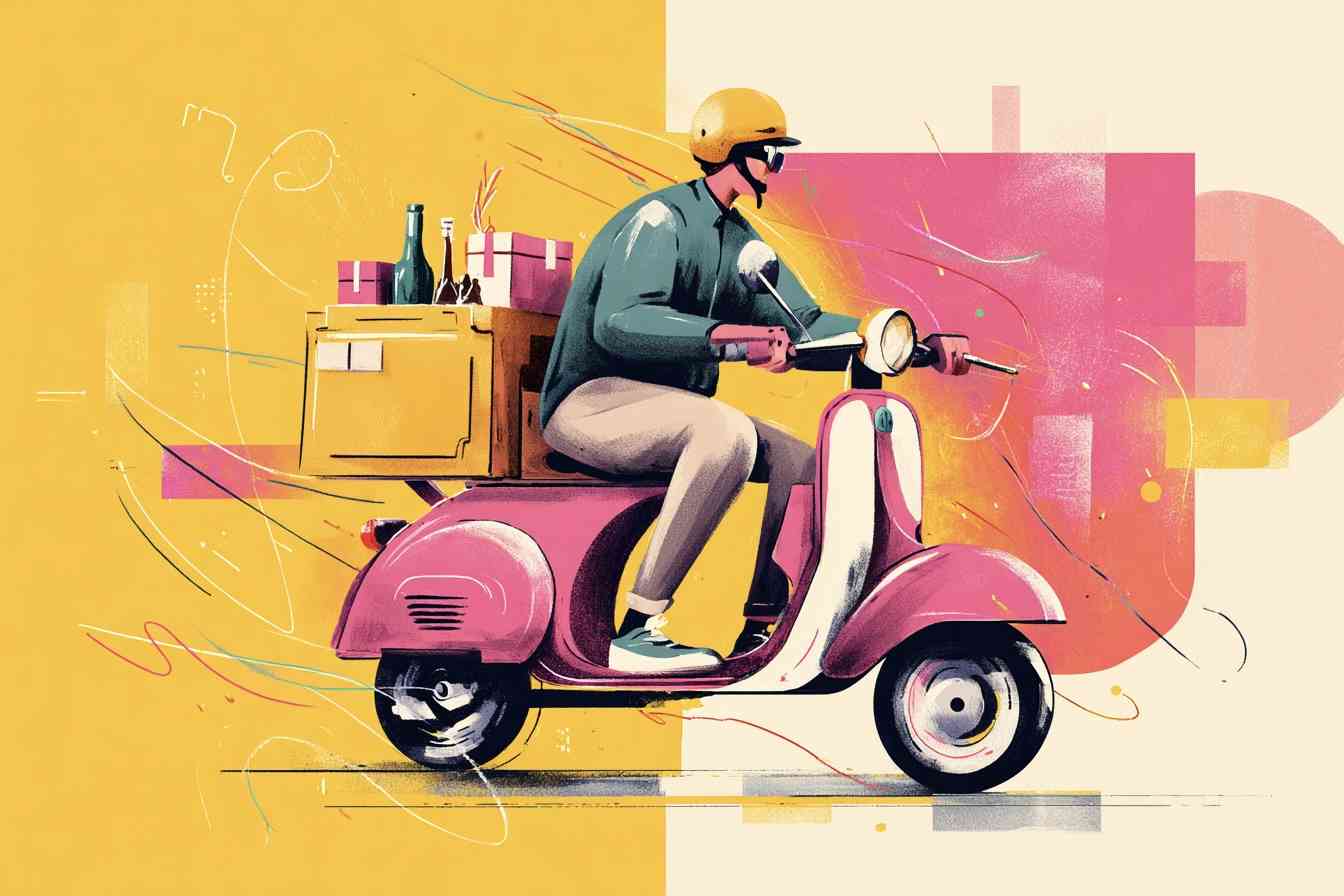The delivery illusion: Delivery giants like Just Eat Takeaway, Deliveroo, and Uber Eats keep losing money yet keep expanding

In theory, companies exist to make profit. Yet in the modern economy, some of the biggest names in the food delivery sector, Just Eat Takeaway, Deliveroo, and Uber Eats, have been operating at a loss for years, all while growing in scale and influence. Their persistent lack of profitability raises an obvious question, if they are not making money, why do they still exist? The answer may lie in a combination of strategic dominance plays, market manipulation, and potentially, deeper agendas that go beyond the stated aim of delivering meals to customers.
The numbers do not add up
Public financial records reveal a striking pattern of sustained losses.
Just Eat Takeaway reported a net loss of 792 million euros in 2022, followed by another significant loss in 2023 (Annual Report 2023, Just Eat Takeaway). Deliveroo, even after years of aggressive marketing and deep market penetration in the United Kingdom, reported pre-tax losses of over £250 million in 2023 (Full Year Results 2023, Deliveroo). Uber Eats, which is part of Uber Technologies, also struggles to produce consistent profits, with the company’s own financial disclosures showing that its delivery segment often operates at break-even or in the red (Q4 2024 Earnings Report, Uber Technologies).
Conventional business thinking suggests that sustained losses should lead to a scaling back of operations or even closure. Yet these companies are doing the opposite. They continue to expand into new territories, pour money into advertising, and offer promotional discounts that further erode margins. This behaviour is not the mark of firms simply trying to stay afloat, it reflects a deliberate strategy.
The growth at all costs model
The official line from these companies is that they are “investing in growth” and “capturing market share.” In reality, this often means keeping delivery fees artificially low, underpaying riders, and placing financial pressure on restaurants through high commission fees that can exceed 30 percent of the order value. Such conditions make it difficult for small, independent food businesses to survive outside the ecosystem of these platforms.
This approach mirrors the predatory pricing strategies used by certain tech giants. Amazon famously accepted years of losses in its retail operations to outcompete and eliminate brick-and-mortar rivals, later raising prices and extracting greater margins once market dominance was secure (The Everything Store, Brad Stone). In the food delivery context, the aim appears to be the same: drive competitors out, absorb their market share, and create a dependency that allows for future exploitation.
The reshaping of urban food culture
The influence of Just Eat Takeaway, Deliveroo, and Uber Eats goes beyond economics. By normalising cheap, app-based delivery as the default mode of ordering food, they are actively reshaping urban dining habits. Many restaurants now derive a large portion of their revenue from these platforms, making them dependent on terms that they cannot easily negotiate.
The consequences of this dependency become clear when platforms alter their fee structures. In multiple markets, commission rates have been raised after dominance was established, reducing already narrow profit margins for restaurants (Food Delivery Apps Take Bigger Bite of Restaurants’ Profits, Wall Street Journal). Some small eateries have reported being unable to survive without the platforms, yet also unable to survive with them due to the high fees.
This dynamic leads to a subtle form of market capture, where the customer’s relationship with the restaurant is mediated entirely through the delivery app. The brand loyalty that once existed between local diners and local restaurants shifts toward the app itself, further cementing the platform’s role as the essential gatekeeper.
Historical parallels in loss-driven dominance
Loss-making as a deliberate competitive strategy is not new. In the late 19th century, John D. Rockefeller’s Standard Oil famously sold kerosene at a loss in targeted regions to bankrupt competitors, later monopolising the market and raising prices. Similarly, rail companies in the Gilded Age would temporarily cut freight rates to levels that destroyed smaller carriers, only to restore them once rivals were eliminated (The Prize, Daniel Yergin).
In the digital age, companies like Uber, Netflix, and Tesla have all relied on sustained investor backing to finance expansion despite operational losses. The difference with the food delivery giants is that their model is inherently low-margin, making true profitability far more elusive. This raises the question of whether profitability is even the primary goal.
Possible deeper agendas
The persistence of unprofitable yet aggressively expanding services invites speculation about other motivations. Several possible agendas stand out.
1. Data harvesting and behavioural control
Every order placed through a delivery platform generates rich datasets, including customer names, addresses, order preferences, payment habits, and even timing patterns that can be linked to lifestyle analysis. These datasets are valuable to advertisers, market researchers, and potentially, governments interested in consumer behaviour tracking (Surveillance Capitalism, Shoshana Zuboff). While public attention focuses on the convenience of a delivered meal, the true asset may be the behavioural data collected along the way.
2. Building infrastructure for automation
Maintaining market share today could be about preparing for a future where human couriers are replaced by autonomous vehicles and drones. In such a scenario, early losses would be justified as an investment in network dominance, so that when automation becomes viable, the market is already captured. The existing delivery fleets, mapping data, and customer loyalty would then be leveraged to operate with much lower costs and higher margins.
3. Market consolidation as financial leverage
The long-term aim may be to consolidate enough of the food delivery market that the platform becomes an indispensable intermediary. Once enough local economies are dependent, pricing structures and partnership terms can be altered to extract maximum value. Investors who tolerated early losses could then reap monopoly-level profits, much as private equity firms restructure acquired industries for cash extraction.
4. Societal restructuring and control
A more controversial but plausible angle is that these platforms are part of a wider trend toward centralising control over essential consumer services. By eroding the direct customer–restaurant relationship, they insert a layer of corporate mediation between people and a basic human need, food. This model is consistent with other sectors where access to essentials is increasingly controlled by a few powerful intermediaries, such as housing platforms, ride-hailing apps, and online marketplaces.
The risk of too big to fail
If food delivery platforms achieve the level of market penetration they are aiming for, they could become too integral to urban economies to fail. In such a situation, governments might be pressured to subsidise or support them during downturns, effectively socialising losses while privatising profits. This is not a hypothetical scenario, as seen during the COVID-19 pandemic when some governments offered financial relief to platform companies under the justification of protecting jobs and maintaining services (Gig Economy in Times of Crisis, OECD).
The danger here is twofold. First, market diversity is eroded as independent delivery networks are squeezed out. Second, the leverage shifts decisively in favour of multinational corporations whose operational decisions can affect thousands of restaurants and millions of customers in an instant.
How dependency is engineered
Dependency is created not only through pricing and promotion, but also through convenience. The psychological ease of ordering via a single app conditions consumers to value speed and simplicity over direct relationships with restaurants. Over time, customers may forget the names of the restaurants they order from, remembering only the name of the app.
Restaurants are also nudged into deeper dependence through exclusive partnership deals. A restaurant that signs an exclusivity contract may receive better promotional placement on the app, but loses the ability to work with competitors. This mirrors the exclusivity tactics used in other industries, such as streaming media, where platforms lock in content providers to prevent customer migration.
Lessons from other industries
History shows that industries dominated by a handful of large players rarely serve the public interest without regulation. The airline industry, for instance, saw intense competition and low fares during deregulation in the late 1970s, but eventually consolidated into a few major carriers that could raise prices and cut services. In telecom, once small competitors were eliminated, consumers faced higher bills and fewer choices (The Master Switch, Tim Wu).
The same trajectory is possible in food delivery. The low prices and generous promotions of today may be replaced by higher fees, reduced service quality, and aggressive monetisation once alternatives disappear.
Conclusion
The official narrative is that Just Eat Takeaway, Deliveroo, and Uber Eats are innovative tech companies temporarily sacrificing profit in pursuit of growth. The unofficial interpretation is more unsettling, their expansion may be driven by motives that have little to do with delivering food. Whether it is the harvesting of behavioural data, the creation of a future automated delivery monopoly, the consolidation of market control, or the gradual restructuring of how society accesses meals, these platforms are changing more than just the way we order dinner.
History has shown that when a small number of entities control the distribution of essential goods, they do not easily relinquish that power. The delivery apps of today may well become the infrastructure of tomorrow’s monopolised, data-driven food economy. Once the market is fully dependent, the public may discover that the convenience they embraced came at the cost of higher prices, reduced choice, and diminished local economic resilience.


















